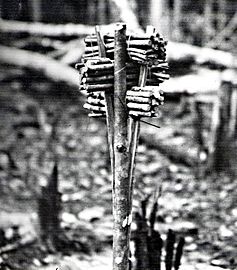Legends tell of a Voodoo Queen of New Orleans who wandered the swamps whispering curses on those who dare cross her...
The word Voodoo conjures up all sorts of dark imagery in the minds of most people today. Dolls with needles strategically stabbed through them, wicked curses beset on unlucky victims and zombification are all common tropes used by pop culture, Hollywood and tourist sectors. However, the religion of Voodoo comprises a much different history that has been clouded over by the era of the Trans-Atlantic Slave Trade, a time that saw the forceful migration populations of West and Central Africans into the New World. What may come as a surprise to most is that most of these ‘myth-conceptions’ actually originated in antiquity in a myriad of Egyptian, Greek, Assyrian and European cultures with many darker elements spawning from the medieval era resurgence of witchcraft coupled with the rise of taboo perceptions of magic in Europe.
The Voodoo Doll may be the single most recognizable misconstrued artifact associated with Voodoo, with many assuming the notion that Voodoo Dolls held a prominent place in various nefarious rituals. In her article from The Materiality of Magic: An Artifactual Investigation Into Ritual Practices Anthology, Natalie Armitage tackles this prominent ‘myth-conception’, making the case that the voodoo doll has been used in misinforming ways in 20th century pop culture films, books etc. Armitage’s research reveals how the first use of image based ‘sympathetic magic rituals’ (sympathetic meaning, like produces like) was discovered in 2nd millennia Assyrian and Ptlomiac Egypt, where magic practices involved a representation of the enemy people or deities that is subjected to mutilation through burning, binding and insertion of nails and other objects. This was a normative practice meant to protect rulers or cities from their enemies and ultimately lacked the same taboo perception that later European cultures focused on during the heydays of witchcraft fear mongering.
The Voodoo Curse is another common trope associated with the little understood religion of Voodoo. The curse beset by a voodoo practitioner has been colored by the nefarious conceptions of magic developed by European culture, which focused on the use of magic and curses as a tool of vengeance or individualized retribution. Armitage suggests that ill-versed foreigners could easily mistake the Bakongo nkisi nkondi, an effigy object used in West African rituals, for a ‘voodoo doll’. Referred to as a ‘fetish’ object (‘fetish’ meaning a talisman, charm, or magical object), the nkisi nkondi can take many forms, unlike magic of Europe that focused on the image of the subject. In place of the image, the main significance of the nkisi nkondi is placed on the arrangement of ingredients, which give life to the spirit being summoned usually for protection from wrongdoing or disease.
Many have pointed to nkisis with nails as a nefarious indication of willing harm on an individual similar to the mutilation of practiced in European witchcraft, however the these nails often represent a connection between the spirit and earthly realms. The driving of nails into a nkisi nkondo can also be likened to a pact or declarations of sorts, wherein the nail is licked by all parties before being driven in, binding them to the agreement. Sometimes, the bearer of the nail is the victim of wrongdoing such as theft, and experiences a catharsis of sorts by driving the nail in to the nkisi nkondi while praying to the spirit to correct the imbalance of good and evil energy.
One idea as to how these ‘myth-conceptions’ could have been constructed has roots in the forceful, repressive migration of Africans into the New World that inevitably resulted in a mixing of cultural and religious practices out of necessity of the enslaved individuals. The misattribution of these taboos can be interpreted as a product of the othering and discrimination inherent to the colonial era that sought to dehumanize Africans fighting maintain their cultural heritage by taking their religious practices ‘underground’ – hidden away from their colonial oppressors. The necessary secrecy of these Voodoo practices arguably invented a new layer of discourse steeped in the fear-mongering taboo semantics of European witch-hunts.
There is no doubt that a violent, chaotic and painful past for Africans living in the Americas has led to the enigmatic syncretic traditions of voodoo we see practiced today. Individuals such as Max Beauvoir, leader of the Haitian Houngan Council comprising over 6,000 Voodoo leaders dedicating their lives to uncovering the mysteries and correcting the misperceptions of Voodoo also reveal the sad state of poverty most voodoo practitioners live in today, a product of hundreds of years of marginalization and suppression from the mainstream.
What have you learned about Voodoo from reading this article? You can contact us via intotheportalmailbox@gmail.com with questions, comments or feedback.
This blog would not be possible without the work of Natalie Armitage in The Materiality of Magic, featured now in Into The Portal’s online Bookstore!
The Materiality of Magic: An Artifactual Investigation Into Ritual Practices and Popular Beliefs. Ed. by Houlbrook, Ceri and Natelie Armitage. Oxbow Book Press, 2015.
As well, I would like to credit Nicole Bianchi for her inspiring blog post on Narrative Introductions - Thank you Nicole!
_________________
Written by Amber Rae Bouchard



